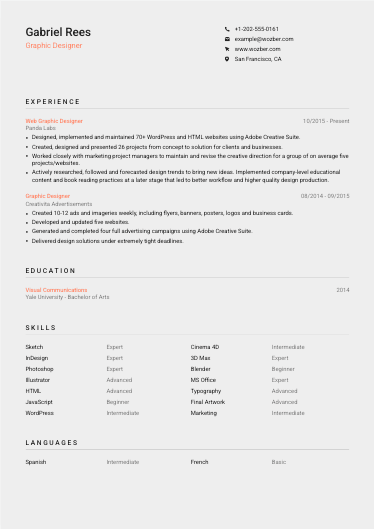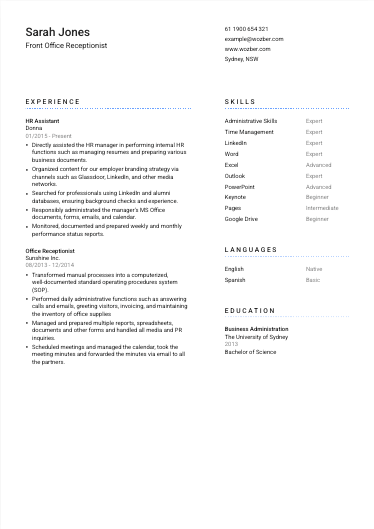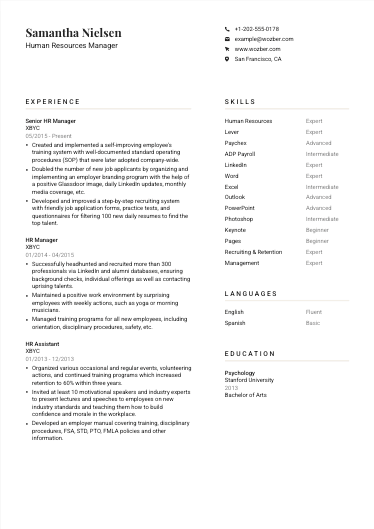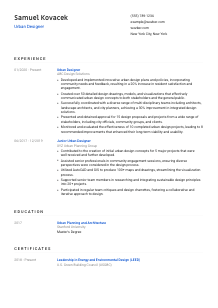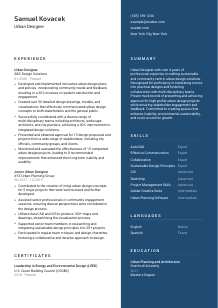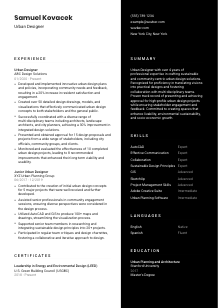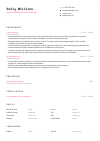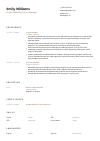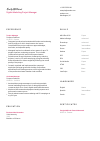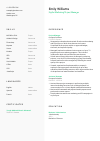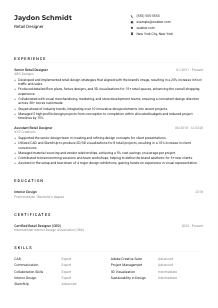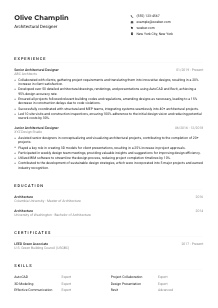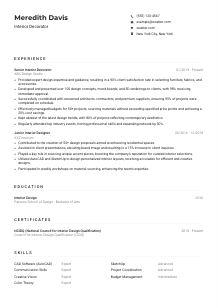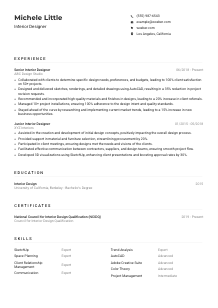Urban Designer CV Example
Shaping cityscapes, but your CV feels a bit suburban? Dive into this Urban Designer CV example, stylized with Wozber free CV builder. Discover how to map your urban vision to job criteria, cementing your career at the heart of forward-thinking landscapes!
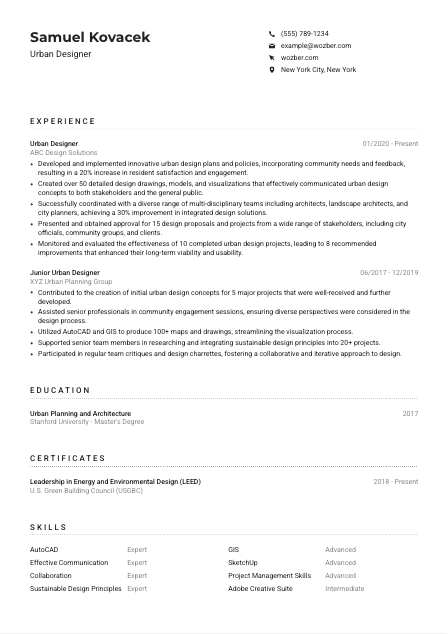
How to write an Urban Designer CV?
Hello, talented Urban Designer! In the bustling city of job applications, your CV needs to illuminate like a well-planned urban skyline. This isn't just about landing a job; it's about cementing your place in an innovative field that shapes our living spaces. With Wozber's free CV builder at your disposal, crafting a CV tailored exactly to the Urban Designer role you're aiming for becomes a streamlined, enjoyable process.
Ready to construct a CV that not only meets the job description you're targeting but radiates your unique professional essence? Let's pave the way to success together!
Personal Details
Consider the Personal Details section the foyer of your professional narrative; the first impression you offer to the hiring world. It's simple, yet pivotal. Here's how to curate it with the precision of an Urban Designer preparing a city layout, making every element purposeful and reflective of the job's requirements.
1. Your Name as a Monument
Think of your name as the central landmark on the map of your CV. Ensure it's prominently displayed with a professional, clear font. It's your brand, your marquee. Make it memorable.
2. Pinpoint the Role Like a Planning Zone
Directly beneath your landmark (name), establish the role you're pursuing. Mirroring the title 'Urban Designer' from the job description instantly clarifies your professional direction and reinforces your suitability for the role.
3. Lines of Communication
Your contact information is the roadmap to you. A current phone number and a professional email address are must-haves. Scrutinize these details as you would a plan for a public space, ensuring accessibility and correctness.
4. Geo-Tagging
Mentioning 'New York City, New York' aligns you with the job's geographical requirements, reassuring employers of your readiness or willingness to be part of the urban fabric they operate in.
5. Optional Blueprint
A professionally updated LinkedIn profile, acting as your personal website, can complement your CV, offering a deeper dive into your projects and achievements. Make sure it's well-structured and mirrors the professionalism of your CV.
Takeaway
Imagine the Personal Details section as the engaging entrance to your professional landscape. Crafted with consideration and aligned with the job's specifications, it welcomes hiring managers into your world. This is the starting point of your narrative journey; make it inviting and impossible to overlook.





Experience
The Experience section is the core district of your CV, where each accomplishment tells a story of impact and expertise. Here's how to model this area to showcase your urban design prowess in alignment with the job description provided.
- Developed and implemented innovative urban design plans and policies, incorporating community needs and feedback, resulting in a 20% increase in resident satisfaction and engagement.
- Created over 50 detailed design drawings, models, and visualizations that effectively communicated urban design concepts to both stakeholders and the general public.
- Successfully coordinated with a diverse range of multi‑disciplinary teams including architects, landscape architects, and city planners, achieving a 30% improvement in integrated design solutions.
- Presented and obtained approval for 15 design proposals and projects from a wide range of stakeholders, including city officials, community groups, and clients.
- Monitored and evaluated the effectiveness of 10 completed urban design projects, leading to 8 recommended improvements that enhanced their long‑term viability and usability.
- Contributed to the creation of initial urban design concepts for 5 major projects that were well‑received and further developed.
- Assisted senior professionals in community engagement sessions, ensuring diverse perspectives were considered in the design process.
- Utilized AutoCAD and GIS to produce 100+ maps and drawings, streamlining the visualization process.
- Supported senior team members in researching and integrating sustainable design principles into 20+ projects.
- Participated in regular team critiques and design charrettes, fostering a collaborative and iterative approach to design.
1. Urban Analysis
Study the job description the same way you would evaluate a new urban development site. Highlight requirements such as 'developing urban design plans' or 'coordinating with multi-disciplinary teams.' These phrases are your keywords for ATS optimisation.
2. Zone Your Roles
Organize your professional history with the latest position first. Clearly outline your job title, company name, and tenure. This clarity and structure make it easy for the ATS and hiring managers to navigate through your career landscape.
3. Designing Achievements
Turn each bullet point into a testament of your accomplishments. Match your achievements to the job description, such as 'Developed urban design plans, incorporating community feedback,' mirroring the job's requisites and illustrating your direct impact on urban spaces.
4. Numbers as Landmarks
Quantify your achievements wherever possible. Saying 'resulted in a 20% increase in resident satisfaction' gives a tangible measure of your work's impact, much like how precise metrics define a successful urban project.
5. Relevance is Key
Stay within the parameters of what's essential for the Urban Designer role. Extraneous information can distract from your core qualifications. Think of this as zoning regulations for your CV; keep each detail purpose-built and relevant.
Takeaway
Curating your Experience section with these steps will construct a compelling narrative, portraying you as a prime candidate for the role. Think of it as designing a community space that's not just functional but transformative. Your CV is your project; make every bullet point a testament to your urban design philosophy.
Education
The Education section of your CV may seem straightforward, but it's the bedrock of your professional qualifications. Here's how to align it with the job requirements and further cement your stance as a top contender for the Urban Designer role.
1. Identifying Structural Requirements
First, isolate the educational requirements listed in the job description, such as 'Bachelor's or Master's degree in Urban Planning, Architecture, or a related field.' These are the cornerstones of your Education section.
2. Blueprint Layout
Structure your educational achievements succinctly. Start with your highest degree of education and include the field of study, institution, and graduation year. This clear framework makes it easy for hiring managers to assess your qualifications at a glance.
3. Tailoring Your Academic Distinctions
If you have exactly what they're looking for – shout it from the rooftops! List your degree in Urban Planning and Architecture prominently. This directly addresses the job's core requirement and solidifies your educational relevance.
4. Supplementary Courses
Though not always necessary for experienced professionals, highlighting specialized courses or workshops related to urban design or sustainable practices can add depth to your qualifications, particularly if you're gearing towards a niche within the urban planning field.
5. Additional Architectural Elements
Include honors, thesis projects, or other academic commendations if they relate closely to urban design. These flourishes can differentiate you, signaling a deep engagement with your field much like a standout feature on a well-designed urban landscape.
Takeaway
Your Education section builds the foundational layer of your professional profile. Strengthen it with clarity and relevance, and let it speak to your expertise and dedication to urban design. This isn't just about where you've studied; it's about showcasing the depth of your commitment to the field.
Certificates
Certifications can significantly bolster your CV, serving as badges of honor that reflect specialized expertise or dedication to continuous professional development. Navigate the certificate terrain with these strategies to ensure they enhance your candidacy for the Urban Designer position.
1. Sift Through Job Prerequisites
Begin by revisiting the job posting for any preferred or required certificates. While our example doesn't express explicit needs, it pays to display certifications that resonate with urban design, like 'Leadership in Energy and Environmental Design (LEED).'
2. Selectively Showcase
Prioritize certificates that align with urban design, sustainable architecture, or other realms specified in the job description. This focused approach serves to enhance your profile, spotlighting your expertise in areas that matter most to the role.
3. Chronological Clarity
For each certificate, include the issuance date to depict the currency of your expertise. This mirrors the ongoing relevance of your skills and knowledge, much like keeping up with the latest urban planning regulations and methodologies.
4. Continuous Urban Growth
Urban design is an evolving field. Demonstrate your commitment to keeping pace with its changes by pursuing new certifications and learning opportunities. This shows potential employers your dedication to professional growth and staying at the forefront of your industry.
Takeaway
Treat your certifications as landmarks within your CV – significant points that draw attention and underscore your qualifications. Chosen carefully and displayed with pride, they speak volumes about your dedication and expertise in urban design.
Skills
The Skills section of your CV acts as a quick-reference guide to your professional capabilities. In the realm of Urban Design, showcasing a blend of technical proficiency and soft skills is crucial. Follow these steps to ensure your Skills section is curated as meticulously as an urban master plan.
1. Decipher the Job Script
Dissect the job description to identify both the stated and implied skills required. Skills like 'proficiency in design and visualization software' and 'strong understanding of sustainable design principles' are your guideposts for ATS optimisation.
2. Highlight Pertinent Skills
List skills that directly match the job requirements, ensuring a mixture of hard skills like 'AutoCAD' and soft skills such as 'Effective Communication.' This demonstrates your comprehensive toolkit, ready to tackle urban design challenges.
3. Organize for Impact
Your skills should be arranged in a manner that balances technical prowess with interpersonal abilities, reflecting a holistic professional profile. This layout helps hiring managers and ATS systems quickly assess your fit for the role.
Takeaway
Consider each skill you list as a bright star in the constellation of your professional qualifications. Together, they map out your capabilities, guiding potential employers through the galaxy of your expertise. Ensure your skills shine brightly and align with the demands of urban design.
Languages
Being multilingual can provide a distinct advantage, particularly in a field as globally influenced as urban design. Here's how to articulate your language skills to support your application, making your CV as universal and inclusive as urban spaces aim to be.
1. Language Requirements
Revisit the job description to identify any specific language requirements. For an Urban Designer role, being able to 'express ideas clearly in English' is a foundational skill, as communication is key in collaborative, multi-disciplinary environments.
2. Prioritize Essential Languages
State your proficiency in required languages at the top. For example, listing 'English: Native' directly addresses a pivotal requirement, immediately assuring the hiring manager of your communication capabilities.
3. Additional Linguistic Abilities
Beyond the essentials, include any additional languages you speak. This not only showcases your versatility but also your capacity to work in diverse, multicultural settings – a valuable trait in urban planning and design.
4. Honesty in Proficiency
Clearly define your level of proficiency using terms like 'Fluent,' 'Intermediate,' and 'Basic.' This honesty provides a clear understanding of your abilities, ensuring expectations are aligned from the start.
5. Projecting Global Reach
In an increasingly connected world, the ability to engage with diverse communities and stakeholders is a tremendous asset. Highlighting your linguistic skills reflects an understanding of and respect for global perspectives in urban design.
Takeaway
Your language skills are more than just a section on your CV; they represent your ability to engage with and understand a diverse array of communities. This is especially crucial in urban design, where global influences and multicultural considerations can shape the success of projects. Present your linguistic abilities with pride, and view them as key to navigating the world of urban design.
Summary
Your CV's Summary section is akin to the architectural concept for a new urban space – it sets the tone and provides a clear vision of what's to come. Here's how to sculpt a summary that encapsulates your professional identity and aligns with the Urban Designer position you're targeting.
1. Absorb the Blueprint
Start by immersing yourself in the job description to understand the essence of what the employer is seeking. Mirror this understanding in your summary, ensuring a direct correlation between their needs and your offerings.
2. Elevating Your Introduction
Open with a statement that positions you as a forward-thinking Urban Designer, highlighting years of experience and specific areas of expertise like 'crafting sustainable, community-centric urban design solutions.'
3. Reflecting Necessary Qualities
Incorporate phrases that directly respond to the job's key requirements. Mention 'proficiency in design and visualization software' and 'experience with sustainable design practices,' underlining your ideal fit for the role.
4. Conciseness is Constructive
Keep this section focused and potent, aiming for 3-5 impactful lines. Like an inviting urban plaza, your Summary should be accessible, engaging, and a reflection of the value you'd bring to the urban design team.
Takeaway
A well-crafted Summary acts as the conceptual foundation for your CV, outlining your professional narrative and core competencies. It signals to hiring managers why you're the Urban Designer who can turn their project requirements into sustainable, vibrant urban spaces. Let your summary invite them into your world, showing them the cityscapes that await under your stewardship.
Launching Your Urban Designer Journey
As we conclude this guide, remember that crafting your Urban Designer CV with Wozber isn't just about meeting job specifications. It's about plotting a course through the landscape of your career, showcasing your unique professional identity, and aligning it with the opportunities ahead. Use this tailored CV example as inspiration to create your own with Wozber's free CV builder, leveraging ATS-friendly CV templates and the ATS CV scanner for optimisation. Your vision for sustainable, engaging urban spaces is needed more than ever.
Let your CV be the map that guides you to your next great project. It's time to design your future!

- Bachelor's or Master's degree in Urban Planning, Architecture, or a related field.
- Minimum of 3 years of professional experience in urban design or master planning.
- Proficiency in design and visualization software such as AutoCAD, GIS, SketchUp, and Adobe Creative Suite.
- Strong understanding of sustainable design principles and experience with sustainable design practices.
- Effective communication, collaboration, and project management skills.
- Must be able to express ideas clearly in English.
- Must be located in or willing to relocate to New York City, New York.
- Develop and implement urban design plans and policies, taking into account community needs and feedback.
- Create detailed design drawings, models, and visualizations to communicate urban design concepts.
- Coordinate with multi-disciplinary teams including architects, landscape architects, and city planners to ensure integrated design solutions.
- Present design proposals and projects to stakeholders, including city officials, community groups, and clients.
- Monitor and evaluate the post-implementation effectiveness of urban design projects and make recommendations for improvements.

